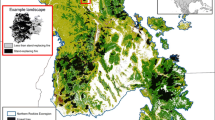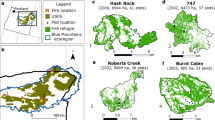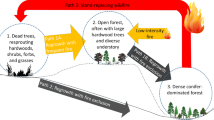Abstract
Context
Landscape and local factors govern tree regeneration across heterogeneous post-fire forest environments. But their relative influence is unclear—limiting the degree that managers can consider landscape context when delegating resources to help stand-replacing patches restock successfully.
Objectives
We investigated how landscape and local factors shape tree regeneration across heterogeneous post-fire forest environments. Our research questions were: What is the relative influence of landscape and local factors on tree species presence (RQ1) and stocking density (RQ2) at stand-replacing patches? Do thresholds occur when landscape factors are influential (RQ3)?
Methods
We sampled landscape and local variables at 71 plots near Jackson, Wyoming, United States. We used Random Forests to investigate how local and landscape variables affect post-fire tree recovery. Relative influence was determined using mean decrease in accuracy. Partial dependence plots were used to visualize whether thresholds occurred for variables with mean decrease in accuracy > 15%.
Results
Landscape factors like seed source area were associated with subalpine fir presence and stocking density. But different thresholds occurred. Specifically, subalpine fir presence required 10% seed source area, while stocking density required 40%. Northeast aspects surrounded by > 10% seed source area were most likely to support subalpine fir presence. Conversely, local factors like soil nutrients were associated with lodgepole pine presence, highlighting effects of different regeneration strategies.
Conclusions
Landscape factors bolster spatial resilience and help stand-replacing patches restock naturally. But landscape factors do not support tree regeneration equally across heterogeneous post-fire forest environments. Consequently, considering stand-replacing patches in their landscape context will be critical for future spatial action planning.







Similar content being viewed by others
References
Abatzoglou JT, Williams AP (2016) Impact of anthropogenic climate change on wildfire across western US forests. Proc Natl Acad Sci USA 113:11770–11775
Addicott JF, Aho JM, Antolin MF, Padilla DK, Richardson JS, Soluk DA (1987) Ecological neighborhoods scaling environmental patterns. Oikos 49:340–346
Alexander RR (1974) Silviculture of subalpine forests in the Central and Southern Rocky Mountains: the status of our knowledge. USDA Forest Service Research Paper RM-121
Allen TFH, Starr TB (1982) Hierarchy: perspectives for ecological complexity. University of Chicago Press, Chicago
Allen CR, Angeler DG, Cumming GS, Folke C, Twidwell D, Uden DR (2016) Quantifying spatial resilience. J Appl Ecol 53:625–635
Archer KJ, Kimes RV (2008) Empirical characterization of random forest variable importance measures. Comput Stat Data Anal 52:2249–2260
Balch JK, Bradley BA, Abatzoglou JT, Nagy RC, Fusco EJ, Manhood AL (2017) Human-started wildfires expand the fire niche across the United States. Proc Natl Acad Sci USA 114:2946–2951
Beers TW, Peter ED, Wensel LC (1966) Notes and observations: aspect transformation in site productivity research. J For 64:691–692
Breiman L (2001) Random forests. Mach Learn 45:5–32
Carpenter S, Walker B, Anderies JM, Abel N (2011) From metaphor to measurement: resilience of what to what? Ecosystems 4:765–781
Certini G (2005) Effects of fire on properties of forest soils: a review. Oecologia 143:1–10
Chapman TB, Schoennagel T, Veblen TT, Rodman KC (2020) Still standing: recent patterns of post-fire conifer refugia in ponderosa pine-dominated forests of the colorado front range. PLoS One 15:e0226926
Cohen J (1960) A coefficient of agreement for nominal scales. Educ Psychol Meas 20:37–46
Coop JD, DeLory TJ, Downing WM, Haire SL, Krawchuk MA, Miller C, Parisien MA, Walker RB (2019) Contributions of fire refugia to resilient ponderosa pine and dry mixed-conifer forest landscapes. Ecosphere 10:e02809
Coop JD, Parks SA, Stevens-Rumann CS, Crausbay SD, Higuera PE, Hurteau MD, Tepley A, Whitman E, Assal T, Collins BM, Davis KT, Dobrowski S, Falk DA, Fornwalt PJ, Fue PZ, Harvey BJ, Kane VR, Littlefield CE, Margolis EQ, North M, Parisien Marc-Andre, Prichard S, Rodman KC (2020) Wildfire-driven forest conversion in western North American landscapes. Bioscience 70:659–673
Cumming GS (2011) Spatial resilience: Integrating landscape ecology, resilience, and sustainability. Landsc Ecol 26:899–909
Cumming GS, Morrison TH, Hughes TP (2017) New directions for understanding the spatial resilience of social—ecological systems. Ecosystems 20:649–664
Davis KT, Dobrowski SZ, Higuera PE, Holdon ZA, Veblen TT, Rother MT, Parks S, Sala A, Maneta MP (2019) Wildfires and climate change push low-elevation forests across a critical climate threshold for tree regeneration. Proc Natl Acad Sci USA 116:6193–6198
Dennison PE, Brewer SC, Arnold JD, Moritz MA (2014) Large wildfire trends in the western United States, 1984–2011. Geophys Res Lett 41:6413–6419
Dilts TE (2014) Climatic water deficit toolbox for ArcGIS 10.1. University of Nevada, Reno
Dobrowski SZ (2011) A climate basis for microrefugia: the influence of terrain on climate. Glob Change Biol 17:1022–1035
Downing WM, Krawchuk MA, Meigs GW, Haire SL, Coop JD, Walker RB, Whitman E, Chong G, Miller C (2019) Influence of fire refugia spatial pattern on post-fire forest recovery in Oregon’s Blue Mountains. Landsc Ecol 34:771–792
Friedman JH (2001) Greedy function approximation: a gradient boosting machine. Ann Stat 29:1189–1232
Gilliam FS (2007) The ecological significance of the herbaceous layer in temperate forest ecosystems. Bioscience 57:845–858
Greenwell BM (2017) Pdp: an R package for constructing partial dependence plots. R J 9:421–436
Gunderson LH, Holling CS (eds) (2002) Panarchy: understanding transformations in human and natural systems. Island Press, Washington
Haire SL, McGarigal K (2010) Effects of landscape patterns of fire severity on regenerating ponderosa pine forests (Pinus ponderosa) in New Mexico and Arizona, USA. Landsc Ecol 25:1055–1069
Hansen WD, Braziunas KH, Rammer W et al (2018) It takes a few to tango: changing climate and fire regimes can cause regeneration failure of two subalpine conifers. Ecology 99:966–977
Hart SC, DeLuca TH, Newman GS et al (2005) Post-fire vegetative dynamics as drivers of microbial community structure and function in forest soils. For Ecol Manag 220:166–184
Harvey BJ, Donato DC, Turner MG (2016) High and dry: post-fire tree seedling establishment in subalpine forests decreases with post-fire drought and large stand-replacing burn patches. Glob Ecol Biogeogr 25:655–669
Hoecker TJ, Hansen WD, Turner MG (2020) Topographic position amplifies consequences of short-interval stand-replacing fires on postfire tree establishment in subalpine conifer forests. For Ecol Manag 478:118523
Hughes TP, Bellwood DR, Folke C, Steneck RS, Wilson J (2005) New paradigms for supporting the resilience of marine ecosystems. Trends Ecol Evol 20:380–386
Johnstone JF, Allen CD, Franklin JF, Frelich LE, Harvey BJ, Higuera PE, Mack MC, Meentemeyer RK, Metz MR, Perry GL, Schoennagel T, Turner MG (2016) Changing disturbance regimes, ecological memory, and forest resilience. Front Ecol Environ 14:369–378
Katul GG, Poggi D (2012) The effects of gentle topographic variation on dispersal kernels of inertial particles. Geophys Res Lett 39:L03401
Kemp KB, Higuera PE, Morgan P (2016) Fire legacies impact conifer regeneration across environmental gradients in the U.S. northern Rockies. Landsc Ecol 31:619–636
Keyes CR, Maguire DA, Tappeiner JC (2009) Recruitment of ponderosa pine seedlings in the Cascade Range. For Ecol Manag 257:495–501
Liaw A, Wiener M (2002) Classification and regression by randomForest. R News 2:18–22
Lipcius RN, Eggleston DB, Schreiber SJ, Seitz RD, Shen J, Sisson M, Stockhausen WT, Wang HV (2008) Importance of metapopulation connectivity to restocking and restoration of marine species. Rev Fish 16:101–110
Loope LL, Gruell GE (1973) The ecological role of fire in the Jackson Hole area, northwestern Wyoming. Quat Res 3:425–443
Lotan J (1976) Cone serotiny—fire relationships in lodgepole pine. Proc Tall Timbers Fire Ecol Conf 14:267–278
Lutz JA, van Wagtendonk JW, Franklin JF (2010) Climatic water deficit, tree species ranges, and climate change in Yosemite National Park. J Biogeogr 37:936–950
McCaughey WW, Schmidt W, Shearer RC (1986) Seed dispersal characteristics of conifers in the inland mountain west. In: proceedings—conifer tree seed in the inland mountain west symposium. United States Forest Service, Department of Agriculture, General Technical Report INT-203, pp. 50–62
Meddens AJH, Kolden CA, Lutz JA, Smith AMS, Cansler CA, Abatzoglou JT, Meigs GW, Downing WM, Krawchuk MA (2018) Fire refugia: what are they, and why do they matter for global change? BioScience 68:944–954
Metzger KL, Smithwick EAH, Tinker DB, Romme WH, Balser TC, Turner MG (2008) Influence of coarse wood and pine saplings on nitrogen mineralization and microbial communities in young post-fire Pinus contorta. For Ecol Manag 256:59–67
Morelli TL, Barrows CW, Ramirez AR et al (2020) Climate-change refugia: biodiversity in the slow lane. Front Ecol Environ 18:228–234
National Forest Management Act (1976) https://www.fs.fed.us/emc/nfma/includes/NFMA1976.pdf Accessed 1 Mar 2021
Olden J, Lawler J, Poff NL (2008) Machine learning methods without tears: a primer for ecologists. Q Rev Biol 83:171–193
O’Neill RV, DeAngelis DL, Waide JB, Allen TFH (1986) A hierarchical concept pf ecosystems. Princeton University Press, Princeton
Peeler JL, Smithwick EAH (2020) Seed source pattern and terrain have scale-dependent effects on post-fire tree recovery. Landsc Ecol 35:1945–1959
Perkins JL (2015) Facilitation of Pinus albicaulis seedling regeneration by Vaccinium scoparium. For Ecol Manag 349:55–65
Peterson G, Allen CR, Holling CS (1998) Ecological resilience, biodiversity, and scale. Ecosystems 1:6–18
Prasad A, Iverson L, Liaw A (2006) Newer classification and regression tree techniques: Bagging and random forests for ecological prediction. Ecosystems 9:181–199
Reader RJ, Buck J (1986) Topographic variation in the abundance of Hieracium floribundum: relative importance of differential seed dispersal, seedling establishment, plant survival and reproduction. J Ecol 74:815–822
Rodman KC, Veblen TT, Battaglia MA, Chambers ME, Fornwalt PJ, Holden ZA, Kolb TE, Ouzts JR, Rother MT (2020) A changing climate is snuffing out post-fire recovery in montane forests. Glob Ecol Biogeogr 29:2039–2051
Schoennagel T, Turner MG, Romme WH (2003) The influence of fire interval and serotiny on postfire lodgepole pine density in Yellowstone National Park. Ecology 84:2967–2978
Seidl R, Rammer W, Spies TA (2014) Disturbance legacies increase the resilience of forest ecosystem structure, composition, and functioning. Ecol Appl 24:2063–2077
Smithwick EAH, Turner MG, Mack MC, Chapin FS (2005) Postfire soil N cycling in northern conifer forests affected by severe, stand-replacing wildfires. Ecosystems 8:163–181
Smithwick EAH, Kashian DM, Ryan MG, Turner MG (2009) Long-term nitrogen storage and soil nitrogen availability in post-fire lodgepole pine ecosystems. Ecosystems 12:792–806
Stephenson N (1990) Climatic control of vegetation distribution: the role of the water balance. Am Nat 135:649–670
Stephenson NL (1998) Actual evapotranspiration and deficit: Biologically meaningful correlates of vegetation distribution across spatial scales. J Biogeogr 25:855–870
Stevens-Rumann CS, Kemp KB, Higuera PE, Harvey BJ, Rother MT, Donato DC, Morgan P, Veblen TT (2018) Evidence for declining forest resilience to wildfires under climate change. Ecol Lett 21:243–252
Tepley AJ, Thompson JR, Epstein HE, Anderson-Teixeira KJ (2017) Vulnerability to forest loss through altered postfire recovery dynamics in a warming climate in the Klamath Mountains. Glob Change Biol 23:4117–4132
Thomson J, Regan TJ, Hollings T et al (2020) Spatial conservation action planning in heterogenous landscapes. Biol Conserv 250:108735
Trakhtenbrot A, Katul GG, Nathan R (2014) Mechanistic modeling of seed dispersal by wind over hilly terrain. Ecol Model 274:29–40
Turner MG, Romme WH, Reed RA, Tuskan GA (2003a) Post-fire aspen seedling recruitment across the Yellowstone (USA) Landscape. Landsc Ecol 18:127–140
Turner MG, Romme WH, Tinker DB (2003b) Surprises and lessons from the 1988 Yellowstone fires. Front Ecol Environ 1:351–358
Turner MG, Smithwick EAH, Metzger KL et al (2007) Inorganic nitrogen availability after severe stand-replacing fire in the Greater Yellowstone ecosystem. Proc Natl Acad Sci USA 104:4782–4789
Turner MG, Braziunas KH, Hansen WD, Harvey BJ (2019a) Short-interval severe fire erodes the resilience of subalpine lodgepole pine forests. Proc Natl Acad Sci USA 166:11319–11328
Turner MG, Whitby TG, Romme WH (2019b) Feast not famine: Nitrogen pools recover rapidly in 25-yr-old postfire lodgepole pine. Ecology 100:e02626
United States Forest Service (2015) Bridger-teton national forest: land and resource management plan. https://www.fs.usda.gov/Internet/FSE_DOCUMENTS/stelprd3840286.pdf. Accessed 24 Feb 2021
Walker B, Holling CS, Carpenter SR, Kinzig A (2004) Resilience, adaptability and, transformability in social-ecological systems. Ecol Soc 9:5
Walker RB, Coop JD, Downing WM, Krawchuk MA, Malone SL, Meigs GW (2019) How much forest persists through fire? High-resolution mapping of tree cover to characterize the abundance and spatial pattern of fire refugia across mosaics of burn severity. Forests 10:782
Wiens JA (1989) Spatial scaling in ecology. Funct Ecol 3:385–397
Wiens JA, Milne BT (1989) Scaling of “landscapes” in landscape ecology, or, landscape ecology from a beetle’s perspective. Landsc Ecol 3:87–96
Wildland Fire Leadership Council (2014) A national cohesive wildland fire management strategy. https://www.forestsandrangelands.gov/documents/strategy/strategy/CSPhaseIIINationalStrategyApr2014.pdf. Accessed 24 Jan 2020
Zakšek K, Oštir K, Kokalj Ž (2011) Sky-view factor as a relief visualization technique. Remote Sens 3:398–415
Zavitkovski J, Newton M, El-Hassan B (1969) Effects of snowbrush on growth of some conifers. J For 67:242–246
Acknowledgements
The National Science Foundation (BCS-1901630), Joint Fire Science Program (1910144), National Geographic, National Aeronautics and Space Administration Pennsylvania Space Grant Consortium, and Penn State Center for Landscape Dynamics funded the study. We thank Hunter Mitchell and Shaina Walker for their hard work in the field, as well as Shelby Duncan for their assistance with the object-based image analysis. We also thank Diane Abendroth and Bridger-Teton National Forest for their logistical support and permitting the study. Laura Leites, Doug Miller, and Alan Taylor served on JLP’s dissertation committee and provided helpful feedback on the manuscript and study.
Funding
The National Science Foundation (BCS-1901630), Joint Fire Science Program (1910144), National Geographic, National Aeronautics and Space Administration Pennsylvania Space Grant Consortium, and Penn State Center for Landscape Dynamics funded the study.
Author information
Authors and Affiliations
Contributions
JLP developed the research vision, designed the study, conducted the quantitative analysis, and wrote the manuscript. EAHS contributed to the study design and provided substantial feedback on the manuscript.
Corresponding author
Ethics declarations
Conflict of interest
We have no competing interests to report.
Additional information
Publisher’s Note
Springer Nature remains neutral with regard to jurisdictional claims in published maps and institutional affiliations.
Supplementary Information
Below is the link to the electronic supplementary material.
Rights and permissions
About this article
Cite this article
Peeler, J.L., Smithwick, E.A.H. Interactions between landscape and local factors inform spatial action planning in post-fire forest environments. Landscape Ecol 36, 3523–3537 (2021). https://doi.org/10.1007/s10980-021-01325-4
Received:
Accepted:
Published:
Issue Date:
DOI: https://doi.org/10.1007/s10980-021-01325-4




